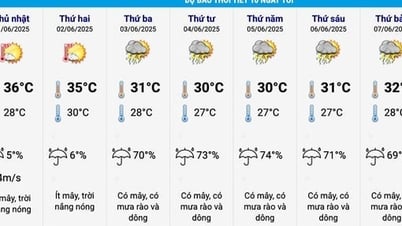World oil prices
At the end of the trading session on May 28, oil prices suddenly jumped more than 1% due to supply concerns when OPEC+ agreed to maintain its production policy and the US banned Chevron from exporting Venezuelan crude oil.

Brent crude rose 81 cents, or 1.26 percent, to $64.90 a barrel. WTI crude rose 95 cents, or 1.56 percent, to $61.84 a barrel.
According to Reuters, at the meeting on May 28, OPEC+ decided not to change its production policy. The organization agreed to establish a mechanism to create baselines for the group's oil production in 2027.
Commenting on the OPEC+ decision, Bob Yawger, director of energy futures at Mizuho, said, “They hoped to slow the pace of production growth and prevent a slide in prices. But that’s not how it played out.”
The eight OPEC+ member countries are expected to meet on May 31 and decide on increasing oil production in July.
According to analysts at Goldman Sachs, these eight members will maintain stable production after the increase in July. However, they also see risks to the OPEC+ supply roadmap, especially if members' compliance levels do not improve or if actual demand data unexpectedly increases.
Janiv Shah, vice president of oil commodity market analysis at Rystad Energy, expects demand to be stronger in the coming period as the summer driving season begins while crude oil production from non-OPEC+ countries remains unchanged in the first half of the year, along with the risk of wildfires in Canada affecting supply.
Regarding supply, on May 28, Chevron terminated its oil production, service and procurement contracts in Venezuela, transferring management of the joint venture to its partner - state-owned company PDVSA, but still plans to retain its employees in the country.
Oil prices are likely to continue to react positively if there is progress in global trade talks or the US-Iran dispute is resolved, analysts said.

Also on May 28, Iran's nuclear agency chief Mohammad Eslami said the country could allow the United Nations nuclear watchdog to send US inspectors to visit nuclear sites if talks between Tehran and Washington are successful.
Meanwhile, data from the American Petroleum Institute showed that US crude inventories fell by 4.236 million barrels in the week ended May 23, compared with analysts' expectations for a 1 million barrel increase. US gasoline inventories continued to fall by a more modest 528,000 barrels. Distillate inventories rose by 1.295 million barrels. The market is awaiting official data from the US Energy Information Administration, expected to be released today.
Domestic gasoline prices
Domestic retail prices of gasoline on May 29 are as follows:
E5 RON 92 gasoline is not more than 19,122 VND/liter. RON 95-III gasoline is not more than 19,532 VND/liter. Diesel oil not more than 17,405 VND/liter. Kerosene not more than 17,314 VND/liter. Fuel oil not exceeding 16,512 VND/kg. |
The above domestic retail prices of gasoline and oil will be adjusted by the Ministry of Finance and the Ministry of Industry and Trade at the price management session this afternoon (May 29). Due to the mixed fluctuations in world gasoline and oil prices last week, domestic gasoline and oil prices will likely be adjusted similarly. It is forecasted that gasoline prices will increase by 50-100 VND/liter, while oil prices will decrease by about 200-300 VND/liter (kg). Oil prices may decrease less because the world oil market will recover some of its "losses" at the end of the trading session on May 28.
In the most recent price adjustment, gasoline prices increased and decreased in opposite directions. While the price of E5 RON 92 gasoline decreased by 58 VND/liter, RON 95-III gasoline decreased by 62 VND/liter, diesel oil increased by 177 VND/liter, kerosene increased by 88 VND/liter and fuel oil increased by 352 VND/kg.
Source: https://baolangson.vn/gia-xang-dau-hom-nay-29-5-xang-dau-trong-nuoc-tiep-tuc-trai-chieu-5048524.html



![[Photo] General Secretary To Lam receives Chief of the Central Office of the Lao People's Revolutionary Party](https://vphoto.vietnam.vn/thumb/1200x675/vietnam/resource/IMAGE/2025/5/30/140435f4b39d4599a3d17975dfb444c5)
![[Photo] National Conference "100 years of Vietnamese Revolutionary Press accompanying the glorious cause of the Party and the nation"](https://vphoto.vietnam.vn/thumb/1200x675/vietnam/resource/IMAGE/2025/5/30/1cf6cd5c8a934ebfa347028dcb08358c)

![[Photo] Journalists moved to tears at the Memorial Service for the soldiers who died in Gac Ma](https://vphoto.vietnam.vn/thumb/1200x675/vietnam/resource/IMAGE/2025/5/30/9454613a55c54c16bf8c0efa51883456)
![[Photo] A delegation of 100 journalists from the Vietnam Journalists Association visits the soldiers and people of Truong Sa island district.](https://vphoto.vietnam.vn/thumb/1200x675/vietnam/resource/IMAGE/2025/5/30/0984a986227d4e988177f560d2e1563e)





















































































Comment (0)